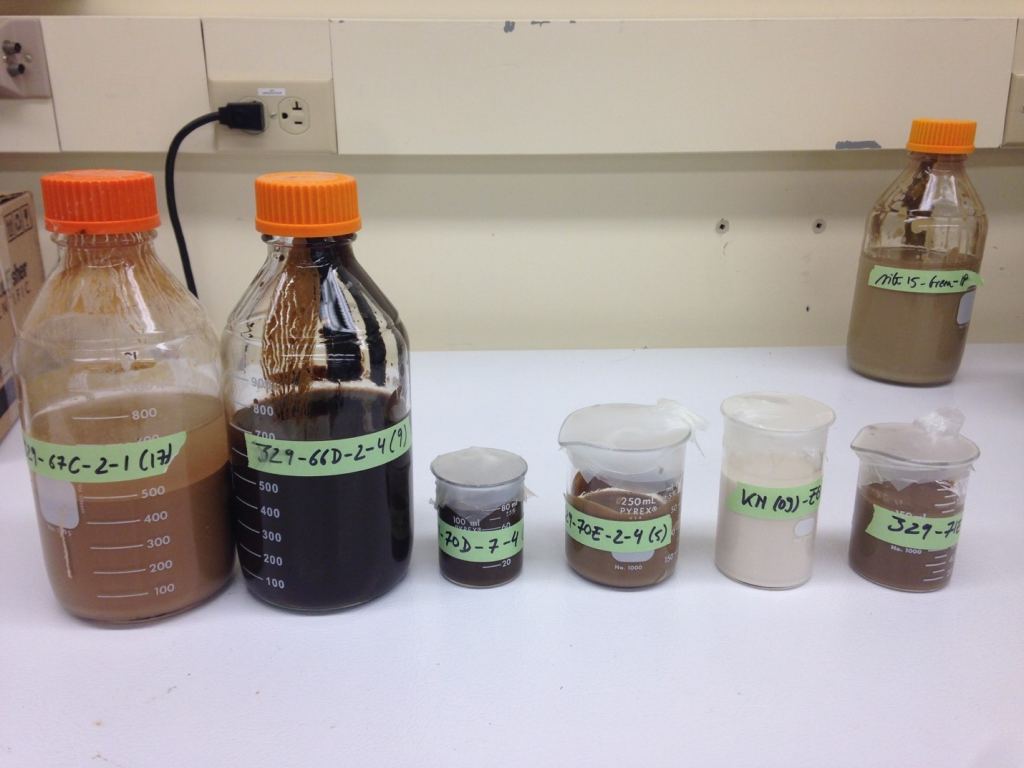Microbes Found That Survive on the by-Products of Radioactive Decay
By Matt Williams
In addition to investigating the big questions about life in our Universe (origins, evolution, distribution, etc.), one of the chief aims of astrobiologists is to characterize extraterrestrial environments to determine if life could exist there. However, there are still unresolved questions about the range of conditions under which life can survive and thrive. Placing better constraints on this will help astrobiologists search for life beyond Earth.
To get a better understanding of how ecosystems can exist beneath the ocean floor (so far from the Sun) a team of researchers led by the University of Rhode Island’s Graduate School of Oceanography (GSO) conducted a study on microbes in ancient seafloor sediment. What they found, to their surprise, was that these lifeforms are sustained primarily by chemicals created by the natural irradiation of water molecules.
The research was led by Justine Sauvage, a postdoctoral fellow at the University of Gothenburg who conducted the research as part of her doctorate at the GSO. She was joined by members from the United States Geological Survey (USGS), the Woods Hole Oceanographic Institution, and the Center for Marine Environmental Sciences (MARUM) at the University of Bremen.

The research team’s findings were the result of a series of laboratory experiments conducted in the Rhode Island Nuclear Science Center. It was here that Sauvage and her colleagues irradiated vials of wet sediment that were collected by U.S. research vessels and the Integrated Ocean Drilling Program from various locations in the Pacific and Atlantic Oceans.
The purpose of this experiment was to measure the rate of radiolysis, where exposure to naturally-occurring radiation causes water molecules to split into hydrogen and oxidants. In contrast to terrestrial life that is fueled by the by-products of photosynthesis, these molecules are the primary source of food energy for microbes living in sediment a few meters below the seafloor.
This radiation-fueled environment, which covers much of the open ocean, is one of Earth’s largest ecosystems. After comparing the production of hydrogen in these sediments to similarly irradiated vials of seawater and distilled water, the team found that the process is amplified by minerals in marine sediment significant (as high as 30 times). As Steven D’Hondt, a URI professor of oceanography and a co-author of the study, said in a URI Today press statement:
“The marine sediment actually amplifies the production of these usable chemicals. If you have the same amount of irradiation in pure water and in wet sediment, you get a lot more hydrogen from wet sediment. The sediment makes the production of hydrogen much more effective.”

The reason for this is unclear, but the team speculates that the minerals in the sediment may behave like a semiconductor, making the absorption of radiation more efficient. Regardless, the implications of this research are significant for astrobiologists, particularly where the search for extraterrestrial life in our own backyard is concerned. As Sauvage explained:
“This work provides an important new perspective on the availability of resources that subsurface microbial communities can use to sustain themselves. This is fundamental to understand life on Earth and to constrain the habitability of other planetary bodies, such as Mars.
Consider the Perseverance rover, which landed on Mars back in February and very recently began driving across the Jezero Crater. The purpose of this mission is to collect samples of Martian rocks for the sake of characterizing the planet’s habitable environments. In addition, the rover will procuring samples from the natural delta formation in the crater (which was created by the deposit of sediment over time) which may contain evidence of past life.
This research could also inform the search for life in exotic environments. For decades, scientists have speculated that the most likely place to find extraterrestrial life could be within icy moons like Europa, Enceladus, and other satellites that are believed to have warm-water oceans in their interiors. Since they are not exposed to the Sun, these environments would be require sources of chemical energy other than photosynthesis.

And then there are extrasolar planets, where astrobiologists are increasingly relied on to help characterize planetary environments and determine if they could be habitable. Said D’Hondt:
“If you can support life in subsurface marine sediment and other subsurface environments from natural radioactive splitting of water, then maybe you can support life the same way in other worlds. Some of the same minerals are present on Mars, and as long as you have those wet catalytic minerals, you’re going to have this process. If you can catalyze production of radiolytic chemicals at high rates in the wet Martian subsurface, you could potentially sustain life at the same levels that it’s sustained in marine sediment.”
There are even implications for the nuclear industry, including the storage of nuclear waste and the managing of nuclear accidents. According to these findings, radioactive waste that stored in sediment and rock would produce hydrogen and oxidants faster than if they were kept in normal water. As these are natural catalysts, this would likely result in the storage system becoming more corroded over time.
Building on their research thus far, the team hopes to explore the effect of radiolysis-driven hydrogen production in other environments. This includes oceanic crust, continental crust on Earth, the subsurface of Mars, and maybe even exoplanets. From this, they hope to advance our understanding of how subsurface ecosystems thrive in the dark!
Further Reading: University of Rhode Island, Nature
The post Microbes Found That Survive on the by-Products of Radioactive Decay appeared first on Universe Today.

March 12, 2021 at 01:24AM
via Universe Today read more...

Post a Comment